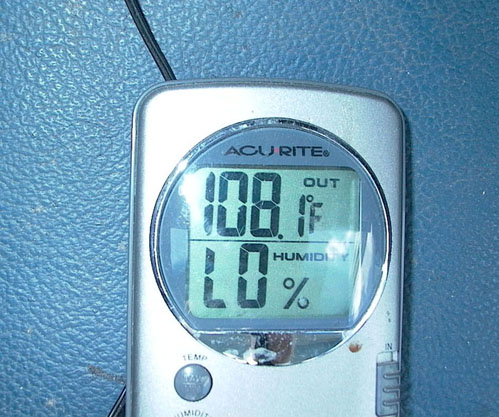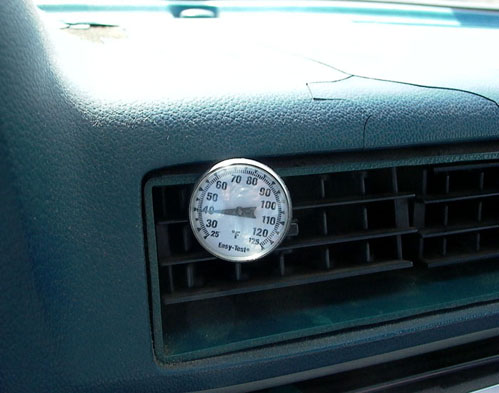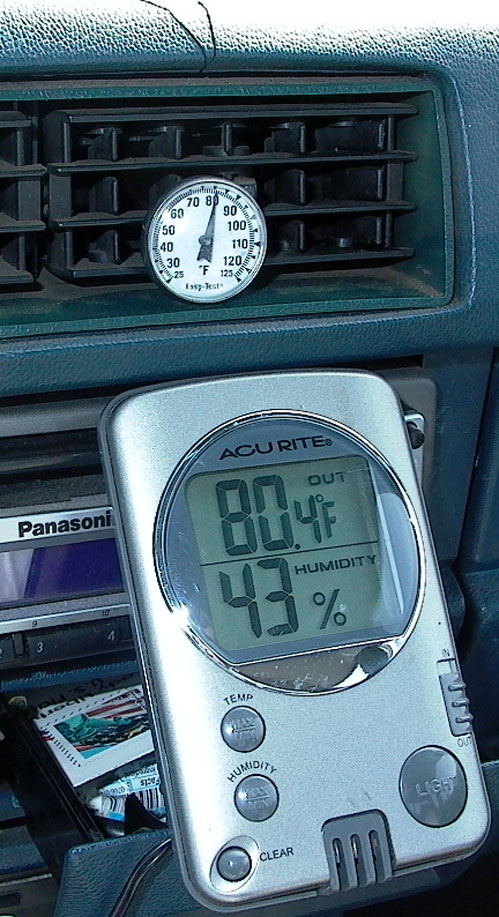Needles, CA in late August? Hot?kassim503 wrote:When you where driving, was it hot out? Was the a/c running?

When you've got A/C, by jingles you're running it on MAX.

Moderators: plenzen, Nissan_Ranger
Needles, CA in late August? Hot?kassim503 wrote:When you where driving, was it hot out? Was the a/c running?


Between the Colorado River and Needles, west I-40.redmondjp wrote:Philip--those two pictures weren't taken at the same time, were they?
Yes, I was using RECIRCULATED air. On FRESH air, the duct temperature was close to 10 degrees higher under these conditions. I tried it.redmondjp wrote:I have been doing my own A/C work (R12 systems only) for the last 20 years, and I've never been able to get more than about a 40 deg. F differential between ambient outside temp. and interior air duct temp.--maybe 35 degrees on a weak system, and 45 degrees on a good one. This is when using outside air into the evaporator and not in recirculation mode.
You've got some kicka$$ system if you can pull a 68 deg. differential! Is this in recirculate mode? You running some kind of magic freon you got from south of the border from the back of some guy's van along the side of the road?
Hes using the good stuff- I noticed warmer a/c temp ducts on every vehicle that I converted to r-134a. Ok fine it was only the maxima and a chevy 1500 p/u. Didnt do them for fun, the old refigerant leaked out, I would never want to downgrade my a/c, even if it made the ozone smile.philip wrote: 11 ) Use genuine Freon R-12 refridgerant. None of that Freeze12 dung or R-134a. The condensor is just too small for that stuff to work in this system when ambients are this high.
Let me say R-12 is not hard to get nor is a license required.kassim503 wrote: SNIP
Too bad R-12 is hard to get, you need a liscence to get it. Too bad
But for the general knowledge that mixed R-12 / R-134a (especially with contaminated lubricant) is corrosive to rubber, I do not have a qualified answer to your question.kassim503 wrote: SNIP
Is there any harm in going back to r-12 after I ran r-134a?
"redmondjp": I took this today while driving south on I-15 past Sun City.redmondjp wrote: SNIP
You've got some kicka$$ system if you can pull a 68 deg. differential! Is this in recirculate mode? You running some kind of magic freon you got from south of the border from the back of some guy's van along the side of the road?


There are a couple of things about this OEM system that are noteworthy.asavage wrote:I agree with JP: that's an incredible temp split. As in "not credible". If it wasn't you claiming it, I'd cry foul.
I've never (before) seen better than 50°F split, and I consider 40° "good", 45° "exceptional".
My driving territory runs from the Pacific Ocean in southern CA to Death Valley. So relative humidities can range from socked in coastal fog to %5, relatively speaking.davehoos wrote:I work as an airconditioning specialist in Newcastle NSW. It's on the coast where humidity is medium/high. Inland from here ambient temps can be high.
As a repair shop in Australia, are you legally prevented from recharging an older R-12 system with R-12?davehoos wrote:We only use R134A as a replacement gas and use PAG oil in passenger cars. Other types can cause warranty issues. Extreme low temp industrial units use other types of oil/gas combinations. Replacement expansion valves and dryers are normally recalibrated to suit R134A. We don't flush systems as a rule but, we blow out "excess" oil if needed. If oil comes out the condensor/evaporator easily then my thoughts are than it would have flowed with the R134A reducing the capacity.
Agreeddavehoos wrote:A/C is more of an art than a science.
I learned my lesson long ago about those "environmentally safe" R-12 replacements and the resulting compromise from using R-134a in an R-12 system. I don't want my A/C sticking it's tongue out (going warm) when ambients are 100 degrees plus!davehoos wrote:I know engineers will not like this statement but some refrigerants work and some do not. For example, I recharged a car today that gave perfect pressure levels. It was serviced by a panel shop as part of paint repair. The system contained Hydro carbon 2%,R12,R134A 96% and a small amount of air. All metal pipes showed no real temp changes tested with my hand. You often see this with blended gas. The good bit settles to the top of the charge station and/or leaks out of the car system, leaving weak refrigerant or air.
Agreed. There is a LOT of metal in copper tubing evaporators that need chilling first.davehoos wrote:Copper evaporator compared to alloy can take a long time to feel cool. These are rare today but some component manufacturers will supply copper for high humidity areas like Darwin NT. Alloy units can have a 2 year life span in these areas.
I disagree with your assumption. My truck has factory (not dealer) installed A/C. The compressor is unique as is the engine's air induction system over the a/c compressor, condenser design, and all the underhood pressure lines compared to the dealer installed kits of the era.davehoos wrote:The drama you have getting suck-through-evap to cool evenly over a long trip is simply not worth the hassels. I think the USA 720 would be of the conventinal set up. Suck through systems are common in Datsuns in the 70-80's. These obviously built without a/c in mind. Aftermaket suppliers often add a fan to operate when used.
As I mentioned earlier, the Datsun has the old school copper tubing evaporator.davehoos wrote:The modern parallel flow condensers are tiny compared to the old Modine and copper tube units. The transfer heat much better if the air flow is reasnable. I have replaced large Modine units with much smaller parallel flow type find that cabin temp is very low at low rpm.
davehoos wrote: Most systems need to cycle to get the best out of them. The compressor turning off allows water to be drained from the evap,and oil/liquid returning to the compressor.
I am in the other camp. Better to have cool liquid refrigerant coming out of the reciever/drier and with that, lower overall pressures. I take it you look for the Hi side / Lo side ratio instead.davehoos wrote:i dont like to overcool the returning liquid,i find expansion valve works better if there is a bigger pressure drop.i like the valve to show signs of adjustment due to the cold sencor on outlet pipe but many dont.in not fused with external equalised valve but im using a oil return that is the same basic setup.
There is only 18" of rubber hose on my low side. The remaining 6-7 feet is aluminum tubing which I insulated from engine heat. In spite of the added insulation, note the heat gained between the evaporator exit and the compressor inlet heredavehoos wrote:The extra insulation on the low side rubber hose is not warranted the oil needs to flow and can freeze in the suction pipe.
The workshop splices new hose sections into old hoses? Those barbed fittings with a couple of hose clamps are more vulnerable to failure than a new hose with swedged fittings.davehoos wrote:SNIP-
Modern hoses are different they have an extra lining inside. but a 20 yr vehicle should be due for replacement. the low side hose will hang in for many years past it due date. this is a large volume of the work at the workshop. cutting of the hoses and wielding in barbed ends to allow replacment hose sections.
All automotive evaporators "sweat" (water condensation on the outside surface of the LO side vapor passages) at some point above freezing (32°F/0°C). This "sweating" flows to the ground freely & continuously. The evaporator core temperature sensor cuts OFF the compressor clutch just above this temperature to prevent the core from becoming a block of ice. ONLY in VERY arid climates are these sensors calibrated to a lower temperature. Unfortunately in vehicles with these sub freezing sensor thresholds, your customer WILL experience evaporator ice-ups when ambient humidity is high ... say above 40% relative humidity. That's when cooling fades away and the driver needs to thaw out the evaporator.davehoos wrote:SNIP
Most evaporators trap water on the metal surfaces.
See previous paragraph of mine.davehoos wrote:New systems don't look at evap core temperature(below -6°C / 21°F), just air temp 1 inch from the core (normally 1-2°C with 2° gap) or the accumlator system low pressure cycling switch (18-30 PSI). this gives 2.5-10°C deg (36-50°F) duct temp. up market cars will add core temp or intake air temp to judge defrost needs. i find that little japanese cars do this well. some have a delayed restart of the compessor. explaining the need to defrost the system to new car buyers, and that annoying customer complaint that it didnt do it before i serviced it. SINCEUWORKEDONIT.
I am not surprised. With the correct balance of R-12 refrigerant liquid to refrigerant gas, the 5:1 (HI side to LO side) ratio (or a bit less) will be achieved. Same to be said about R-134a. When the balance has excessive gas, high pressures soar and cooling decreases. Excessive HI side pressure is hard on the compressor and magnetic clutch. HI side hoses sometimes blow.davehoos wrote:I read that R12 has a 5:1 ratio and R134A has a 7:1 ratio. not seen this myself.
If I understand this "correlation" correctly, your high side pressures are ignored? So ... what is the optimal "low side/vent temp" ratio you aim for in an R-12 system?davehoos wrote:I look at the low side/vent temp ratio - with very low pressure the pump will die.
Another indication of system over charging with R-12, likely excessive refrigerant gas, or failure to dissipate heat has occured.davehoos wrote: SNIP. The high side should have pressure/temp cut outs. some hot days are enough to trip the sencor without the pump turning on. many common sold cars have an independant fan switch that operates at 250-350 psi.
I would NEVER follow this refrigerant replacement suggestion. Not ever, regardless be the refrigerant R-12 or R-134a. The reasons are obvious.davehoos wrote:if this is the case convert to R404. with R404, at rest pressure can be 200+psi. Running, high side 450+psi: low side 10 psi.
At 100°F, what actual HI/LO pressure and DUCT temperature readings do you achieve in that vehicle? And at what relative humidity?davehoos wrote:i looked up my 1973 leyland P76 book-
R12. york 8.7 inch. ambient temp 100F
220 psi:29 psi gives 30F evap temp.
1500RPM. that not 5:1.
Clarification. When recharging from an evacuated state, the Datsun FSM says to warm the charge can in warm water for only a few minutes ONLY WHEN the system is slow to take refrigerant. This slow acceptance indicates too much gas / pressure has been put into the system.davehoos wrote: SNIP-
gassing vehicles. (aka "recharging")
The book shows that heating the bottle or pumping in set amount of gas is the way its done.
This is a half truth. The FSM dictates (1)the compressor is NOT running while refrigerant is being installed into an evacuated system and (2) that BOTH pressure gauge service valves are OPEN to admit gas refrigerant.davehoos wrote: SNIP- Putting in liquid from a bottle can cause hydrolic lock or freeze shatter the reed valves in the pump. its easy to do.
Again, in the context of Datsun truck with R-12. I'm not understanding what you mean by "accumulator."davehoos wrote:same deal with a vehicle in cold weather. the accumulator systems are good for this purpose. liquid is at the bottom and vapour is drawn from the top. SNIP
Users browsing this forum: No registered users and 3 guests